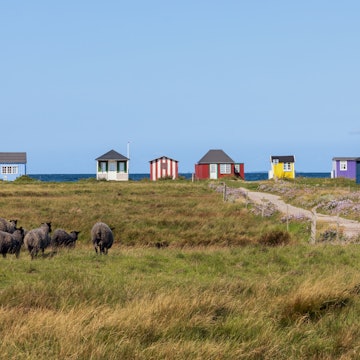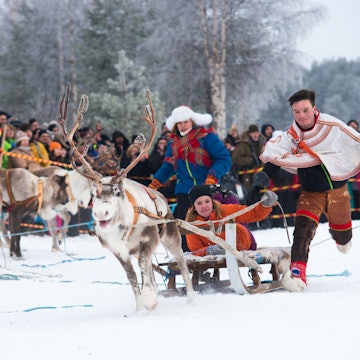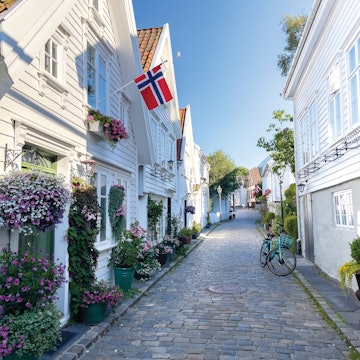

A voyage on the iconic Hurtigruten coastal ferry is a spectacular way to see Norway's coast © Robert Waleczek / Guest Image / Hurtigruten
Seeing the Northern Lights is high on many travellers’ bucket lists but unlike other attractions – the Taj Mahal, say, or Machu Picchu – where if you follow a map they'll definitely be there, that’s not the case with this natural wonder. Lonely Planet writer Bernice Harrison travelled along Norway's coast on an iconic Hurtigruten voyage in search of the elusive aurora borealis.

It’s not hard to think that a company that offers a Northern Lights cruise is tempting fate. Days can go by when cloud cover or poor weather prevents the aurora from lighting up the sky, and just being in a part of the world where sightings are common doesn’t guarantee anything. So there was a giddy sense of excitement among the passengers boarding Arctic cruise specialist Hurtigruten’s ship the MS Nordnorge for a seven-day cruise travelling north from Bergen to Kirkenes, hugging the coast of Norway and crossing the Arctic Circle.
From the first day this seems like a cruise for people who would normally consider themselves cruise phobic: good anoraks, strong shoes and cosy hats are the dress code. The Nordnorge isn’t a mega vessel; it’s not one of those sea-worthy skyscrapers where there’s an entertainment director and glitzy shows for the thousands of passengers. Instead there are talks every day on subjects ranging from the Norwegian way of life to Arctic expeditions, and passengers are encouraged to engage with the passing landscape through the many “points of interest” alerts – announced over the intercom – to head to the open seventh deck to get a better view.

These include the Trollfjord, a spectacular, spooky fjord, especially when passed through in darkness, its steep walls lit up by the ship’s lights; and the moment when the ship crosses into the Arctic Circle. At this point a certificate marking the moment is given to each passenger, which sounds corny, but once you get into the cruise spirit anything is possible.
If you’re travelling on the Nordnorge, a tip for any of these alerts is to avoid the packed seventh deck with its photo-hungry passengers – some with tripods and pro-calibre cameras, elbows out jostling for a better position. Head for the much quieter, open fifth deck instead, whose exterior walkway encircles the boat.
Hurtigruten has been operating in these waters for more than 100 years, first as a cargo and postal service serving local communities, then from the 1950s and 1960s when tourism took off as a growing passenger cruise company. But although the ships have been adapted for the tourist market, it’s still very much a means of transport for Norwegians; locals hop on and off to make short journeys up and down the coast and it makes for a more authentic experience.

Where Hurtigruten falls into line with other cruise companies is with the pricey – though optional – daily excursions. There’s a huge choice, from kayaking to husky sledding and prices vary, but to get an idea of the cost, a guided walk available at most of the daily stops the ship makes costs from about €70. Some of the excursions aren’t worth the money, but one that’s a must is the trip to the North Cape, the most northerly accessible point on the European continent. Departing from the port of Honningsvåg, the excursion crosses the 71st parallel and costs approximately €195. In late autumn, when this trip was made, the light was bright, the air crisp and the landscape snowy and spectacular.
The huge range of terrific food available at breakfast, lunch and dinner means that the “cruise kilo” is unavoidable, and its provenance is also explained; there is an emphasis on local produce, with fish caught every day. Wine is eye-wateringly expensive, though (from €13 for a small glass) – this is Norway after all. There is also a separate, small fine-dining restaurant on the Nordnorge.

On the fifth night, just as the ship had left Tromsø and the soup course (traditional barley soup – delicious!) was about to be served, the announcement came over the intercom that the Northern Lights could be seen. Spoons were dropped, chairs pushed back as diners grabbed their coats off the back of their chairs (most came prepared) and raced out on deck.
Overhead were great swirling clouds that appeared to the naked eye as off-white or grey, but when the lights were photographed with a high-end camera – or through one of the many Northern Lights apps available – the distinctive green colour comes through. Filmed on a basic smartphone it’s simply a black sky.
The following night, at the little earlier time of 6pm, the light show started up again, this time without any of the light pollution from the town of Tromsø so even to the naked eye the colour appeared light green with flashes of red as it swirled across the starry sky giving a spectacular display that lasted for the best part of two hours. The lights moved through the sky with such urgency it was easy to understand why in Viking mythology they were thought to resemble Valkryie armour as they went into battle.
You might also like:
Chasing the Northern Lights in Norway
Rent a Norwegian island with amazing views of the Northern Lights
The Lofoten Islands, Norway: there but for the grace of cod
Bernice travelled to Norway with support from Hurtigurten. Lonely Planet contributors do not accept freebies in exchange for positive coverage.














